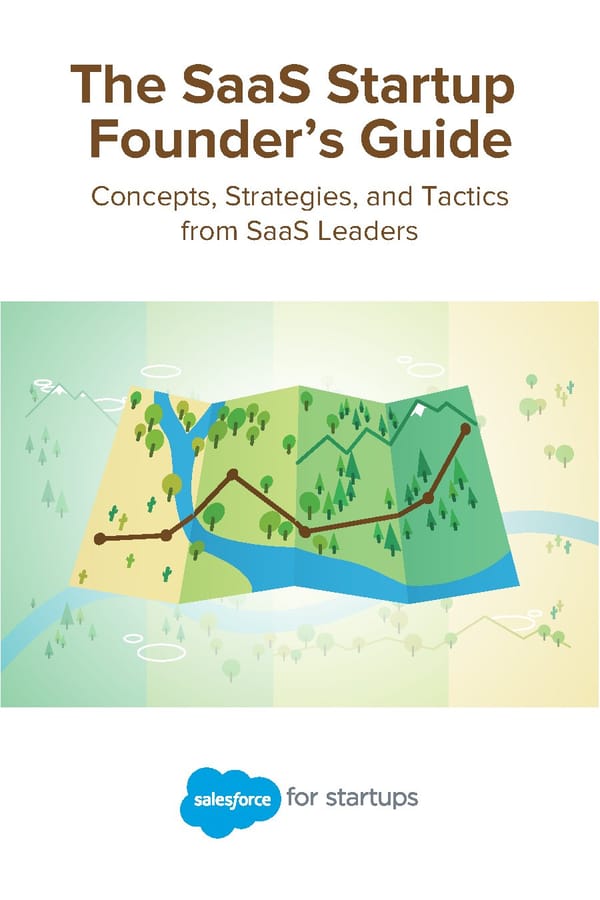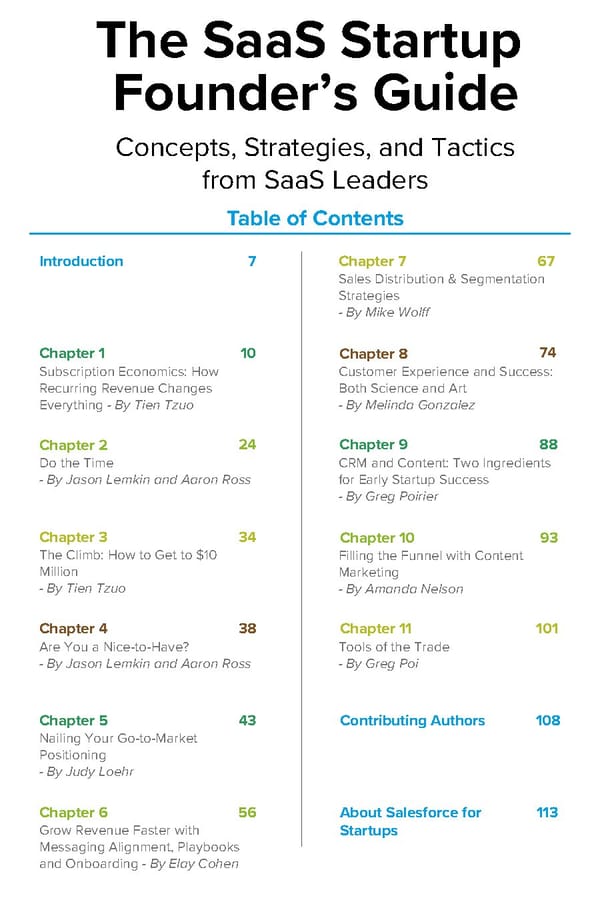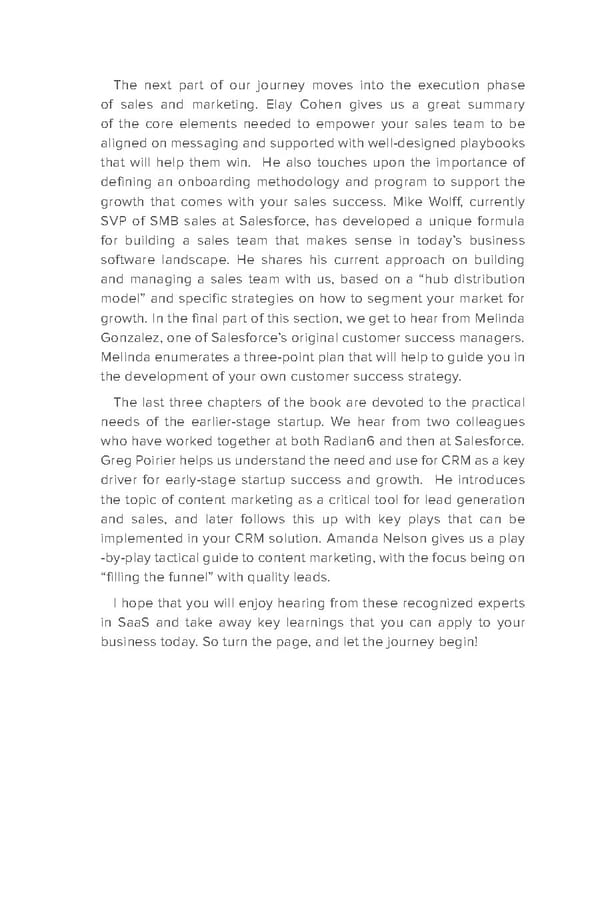Acknowledgments & Introduction
By Managing Director at Salesforce Incubator | Startup Advisor
The SaaS Startup Founder’s Guide Concepts, Strategies, and Tactics from SaaS Leaders
Chapters 2 and 4 by ©John Wiley Sons, Inc., From Impossible to Inevitable, First Edition. Reprinted by permission of John Wiley & Sons, Inc. ©salesforce.com, inc., All rights reserved for all other chapters. Salesforce.com, inc. The Landmark at One Market, Suite 300, San Francisco, CA 94105, United States
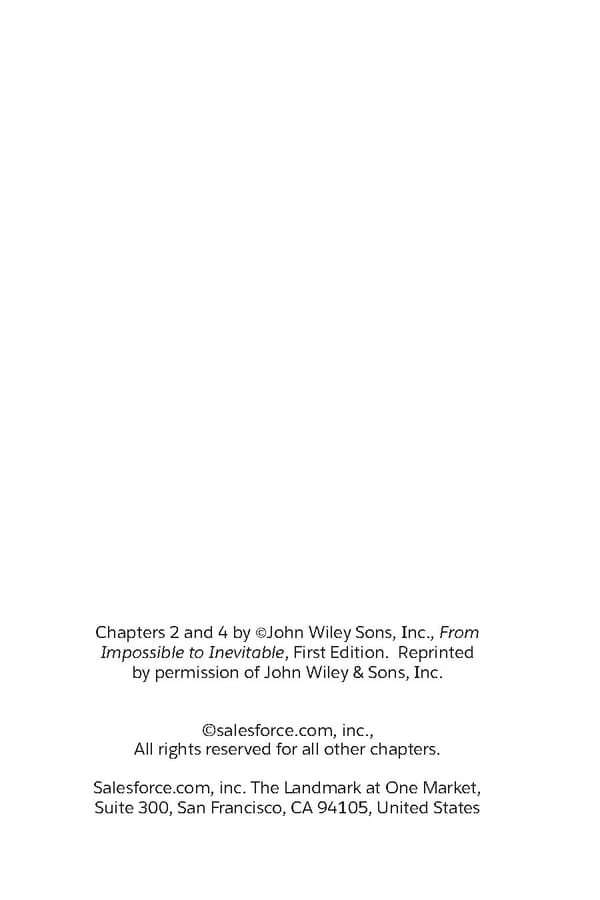
The SaaS Startup Founder’s Guide Concepts, Strategies, and Tactics from SaaS Leaders Table of Contents Introduction 7 Chapter 7 67 Sales Distribution & Segmentation Strategies - By Mike Wolff Chapter 1 10 Chapter 8 74 Subscription Economics: How Customer Experience and Success: Recurring Revenue Changes Both Science and Art Everything - By Tien Tzuo - By Melinda Gonzalez Chapter 2 24 Chapter 9 88 Do the Time CRM and Content: Two Ingredients - By Jason Lemkin and Aaron Ross for Early Startup Success - By Greg Poirier Chapter 3 34 Chapter 10 93 The Climb: How to Get to $10 Filling the Funnel with Content Million Marketing - By Tien Tzuo - By Amanda Nelson Chapter 4 38 Chapter 11 101 Are You a Nice-to-Have? Tools of the Trade - By Jason Lemkin and Aaron Ross - By Greg Poi Chapter 5 43 Contributing Authors 108 Nailing Your Go-to-Market Positioning - By Judy Loehr Chapter 6 56 About Salesforce for 113 Grow Revenue Faster with Startups Messaging Alignment, Playbooks and Onboarding - By Elay Cohen
Acknowledgments I would like to express my gratitude to the many people who helped to support this project; to all those who talked things over with me, read, wrote, offered comments, allowed me to “quote” their remarks, and assisted in the editing, proofreading, and design. I would like to thank Ally Denton for the excellent copywriting work done (especially over the holidays), Melanie Picard for cracking the whip as project manager, and Daniel Acuff for his judicious proofreading. Thanks to Julia Barrett for working through initial concepts of the book with me and Ludovic Ulrich for inspiring me to write it — without the both of you this book might never have found its way to completion. A special thanks to Aaron Ross and Jason Lemkin who graciously contributed chapters from their upcoming book, From Impossible to Inevitable. I have known Aaron since the early days at Salesforce and Jason from his early days at EchoSign. Both have been great friends and inspiring mentors over the years for the SaaS community at large. Last and not least: I want to sincerely thank all of my friends who have contributed their wisdom and experiences to this book — Tien Tzuo, my original mentor at Salesforce; Judy Loehr, for onboarding me at Salesforce and continuously championing the AppExchange ecosystem as much as I did; Elay Cohen, the most engaging sales productivity guru I know; Mike Wolff, the sales guy everyone respects, and honorary Canadian; Melinda Gonzalez, for her pioneering work at Salesforce and willingness to contribute to this book; Greg Poirier, startup advocate, advisor, and mentor; and Amanda Nelson for jumping in with both feet after a 10-minute conversation at Dreamforce. Mike Kreaden San Francisco
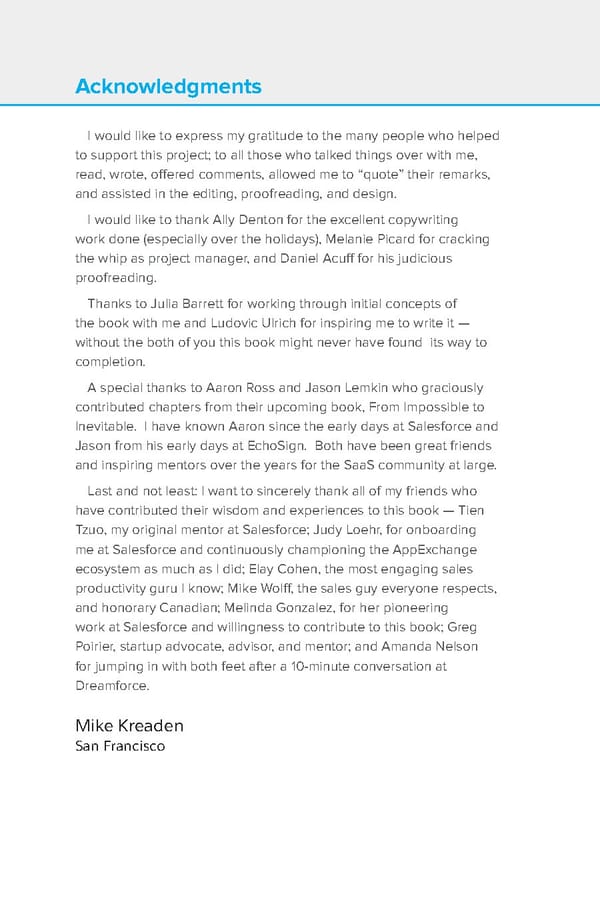
AcknowledgmentsIntroduction A lot has changed in the 14 years since I started working at Salesforce as a product manager (there were only four of us on the team at the time). In 2002, Salesforce was a classic startup, but was already exhibiting signs as an outlier. We were closing our second year of revenue at the time − rocketing from $5 million to $22 million. In my first month on the job, I was amazed at how such a young startup could operate and behave with the discipline needed to handle this growth. Sales, marketing, and operations were mature and efficient machines. Over the years, I have tried to help other startups understand what we were doing, how we were doing it, and more importantly — why we did it the way we did. I was keenly aware that we were pioneering not only a new technology model, but also a new business and philanthropic model as well. This book is dedicated to you — the startup SaaS entrepreneur. Those of you who collectively have or are changing the world. That change is manifested in the core distribution and consumption model of what we do — software as a service (SaaS). In the early years, I would learn from Tien Tzuo (my boss at the time) about the paradigm shift that we were evangelizing. The move to a subscription-based business model, with all of the requisite changes needed to market, sell, and support that service. In the early years at Salesforce, I can remember Marc Benioff’s fanatical cry about customer success as our number one value, which gave rise to the newfound role of customer success manager. At the time, we were just starting to understand the dynamics of contract renewals and managing churn. The epiphany came when we understood that our investment in the success of our customers had a direct impact on our renewals number. This was not an expense for the company, it was a cost of sale. The important shift from annual contract value (ACV) as a key metric of sales success, to total lifetime value (TLV), allowed us to unlock second-order revenues from our customer base and helped to dramatically reduce churn.
Chapter 1 This was but one of the many nontraditional business strategies that Salesforce employed to become the undisputed leader in enterprise SaaS. This book is meant to provide you with key learnings from industry luminaries and experts. It was only later, while managing the AppExchange Incubator in Silicon Valley, that I would start to catalog some of our sales and marketing plays in order to share them with our cohort companies. We would invite guest speakers from around the company, to come in and share their knowledge and experience with these early-stage companies. This effort then formed the basis of our enablement track that we provided to our AppExchange partners, where we ran workshops on sales and marketing to help them get the fundamentals right as fledgling SaaS companies. It was only after we launched the Salesforce for Startups program last year, that I finally had a compelling reason to compile this information out to our ecosystem membership and the startup community at large. This book is very much a compendium of topics related to building a great SaaS company. It is meant to provide the reader with a fundamental understanding of the underlying business model of SaaS, as well as key go-to-market plays that will help to guide you and your growing company. Our journey begins with an analysis of the business paradigm shift itself − the shift to the subscription economy. Tien Tzuo is credited with coining this phrase, and was lecturing on this topic at the Stanford Graduate School of Business almost 10 years ago. We will then get some insights into what it looks like to build a high- growth and sustainable SaaS company. Jason Lemkin will test our understanding of what it really takes to make it as a SaaS founder, followed by Tien providing his summary of what the arc of success looks like for the SaaS startup, from founding to $10 million in recurring revenue. Next we will touch upon product/market fit and positioning. Aaron Ross gets to the heart of it when he poses the question, “Are you a nice-to- have?” He posits that targeting the needs of your customer is an ongoing activity and cites some great examples to help you understand enterprise buyer dynamics. Judy Loehr follows this up with the immense practical experience she brings to the topic of company and product positioning. She provides us with a sound framework to develop our company positioning with some clear exercises to help us put this into practice.
Chapter 1 Subscription Economics: How Recurring Revenue Changes Everything The next part of our journey moves into the execution phase of sales and marketing. Elay Cohen gives us a great summary of the core elements needed to empower your sales team to be aligned on messaging and supported with well-designed playbooks that will help them win. He also touches upon the importance of defining an onboarding methodology and program to support the growth that comes with your sales success. Mike Wolff, currently SVP of SMB sales at Salesforce, has developed a unique formula for building a sales team that makes sense in today’s business software landscape. He shares his current approach on building and managing a sales team with us, based on a “hub distribution model” and specific strategies on how to segment your market for growth. In the final part of this section, we get to hear from Melinda Gonzalez, one of Salesforce’s original customer success managers. Melinda enumerates a three-point plan that will help to guide you in the development of your own customer success strategy. The last three chapters of the book are devoted to the practical needs of the earlier-stage startup. We hear from two colleagues who have worked together at both Radian6 and then at Salesforce. Greg Poirier helps us understand the need and use for CRM as a key driver for early-stage startup success and growth. He introduces the topic of content marketing as a critical tool for lead generation and sales, and later follows this up with key plays that can be implemented in your CRM solution. Amanda Nelson gives us a play -by-play tactical guide to content marketing, with the focus being on “filling the funnel” with quality leads. I hope that you will enjoy hearing from these recognized experts in SaaS and take away key learnings that you can apply to your business today. So turn the page, and let the journey begin!

